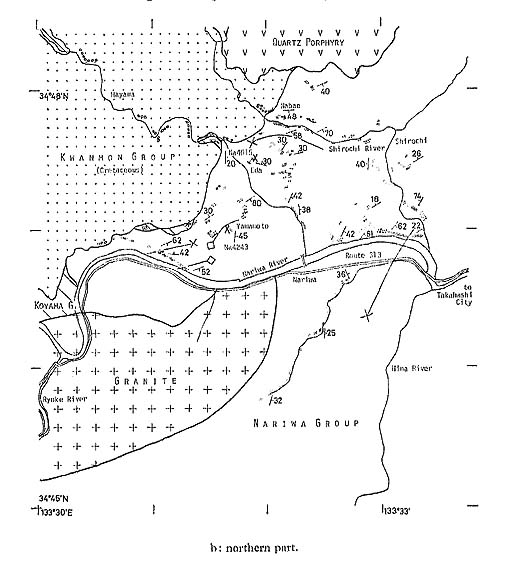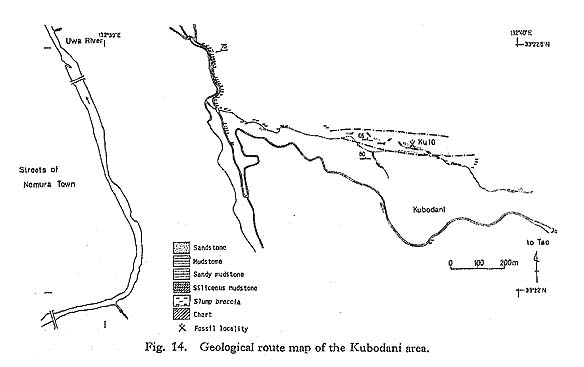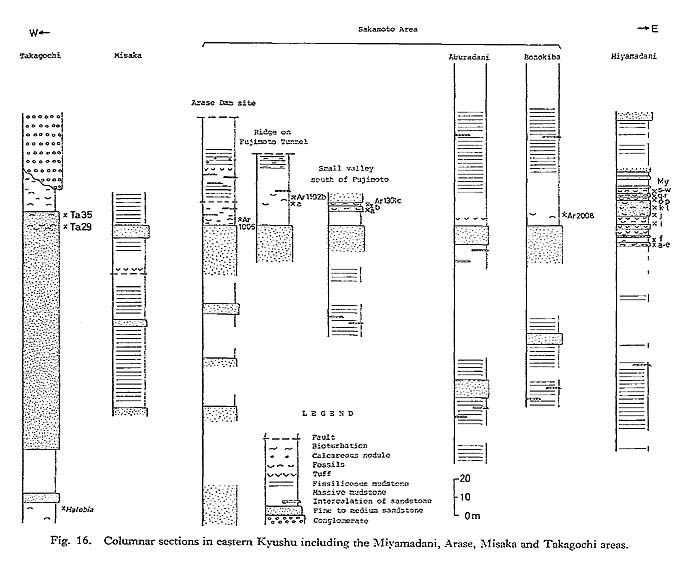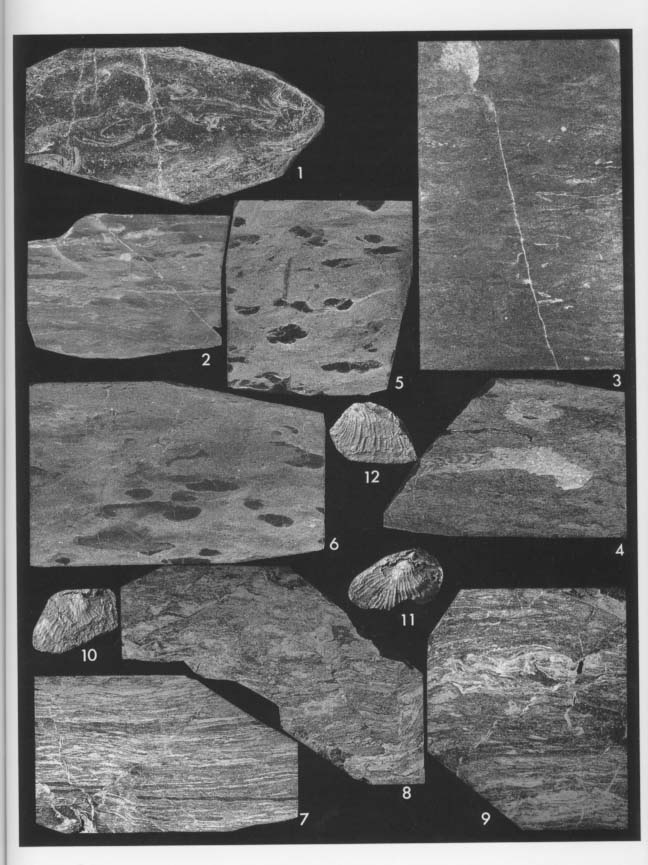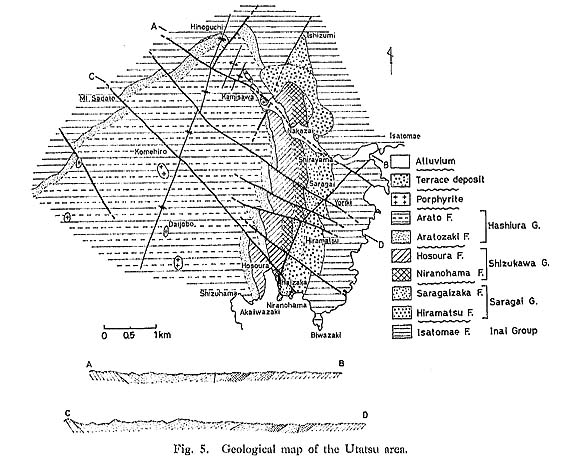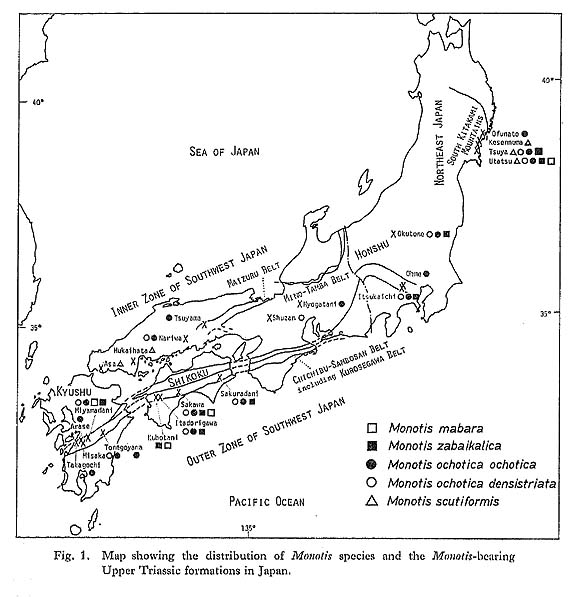CHAPTER 2
Geological Setting of Monotis-bearing Formations
3. Outer Zone of Southwest Japan (including Kwanto Mountains)
|
The occurrence of Monotis in the Outer Zone of Southwest Japan is known, in eleven areas, from the easternmost Ohme area to the westernmost Takagochi area. Because the Ohme and Itsukaichi areas in the Kwanto Mountains belong to the extension of the Outer Zone, they are included here. The Monotis-beaving formations in this zone are traced along the Kurosegawa Belt and its adjacent zones in the Chichibu-Sambosan Belt. These formations show very complicated zonal structure and have only limited distributions in most of these areas so that it is difficult to establish the stratigraphy. Only in the Miyamadani, Arase and Takagochi areas of the western Kyushu, are relatively reliable Monotis sequences obtained, as previously described by Tamura (1965). The Monotis-bearing formations of this zone are known as the Kochigatani Group, the type locality of which, Kochigatani, is situated in the Sakawa area of Shikoku. They consist of shallow-sea sediments composed of conglomerate, sandstone, mudstone and subordinate sandy limestone. On the other hand the Upper Triassic formations of the Chichibu-Sambosan Belt, except for the Monotis-bearing formations, are dominated by chert and limestone. The chert-limestone fades may be quite different from the shallow-sea facies of the Monotis-bearing formations. A thick pelagic limestone in the Konose Group along the Kuma River in southwestern Kyushu, which is distributed along the southern margin of the Sambosan Belt in the Outer zone, includes biomicrite containing a great number of extremely thin shells and their fragments (Kanmera, 1969). Kanmera discriminated four types of shells and suggested that two of them may be identified as Halobia, Daonella or Bositra and Otapiria. Though the mode of occurrence of these shells is somewhat similar to that of the Monotisbeds, the lithology is quite different. The difference of lithology between this limestone and the Monotis-beds may be a consequence of deposition in different sedimentary environments. 1) Ohme Area (Kanyo Formation)In the Ohme area, in the western part of Tokyo Prefecture, only a single specimen of Monotis ochotica ochotica was collected by Takagi (1944). Since then no fossils have been discovered at this locality. Ozawa (1975) named the Monotis-bearing bed the Ishigami Formation and described it is narrowly distributed and fault-bounded. Recently, Ozawa and Kobayashi (1986) renamed it the Kanyo Formation. According to them, it is composed of massive sandstone with two to four conglomerate layers, interbedded sandstone and mudstone, and dark gray mudstone. The lowest part of the formation consists of granule-bearing very coarse- to coarse-grained, arkosic sandstone with graded, crossand parallel-laminated structures. Sandstones of the formation are generally quartzose. The thickness is estimated to be 200 to 250 meters. They thought that the Kanyo Formation overlies the Kayakubo Formation unconformably. The bed in which Takagi discovered Monotis belongs to the lower part. The specimen mentioned (UMUT MM5059) is contained in dark gray, slightly micaceous, poorly sorted, fine-grained sandstone. 2) Itsukaichi Area (Kayakubo Formation)The first discovery of Monotis at Iwai in the Itsukaichi area of the western part of Tokyo Prefecture was reported by Fujimoto (1926). Triassic formations are thought to be distributed in four minor blocks, each with distinctive internal stratigraphy and structure and in. fault contact with adjacent blocks. Geological investigations were carried out by Ichikawa and Kudo (1951), Ichikawa (1951b, 1954c) and Sakagami (1955). According to Ozawa and Kobayashi (1986), the stratigraphy can be summarized as follows: Kayakubo Formation (=Entomonotis Bed by Ichikawa and Kudo, 1951) (Norian) 15-20 m Mainly composed of dark gray to dark greenish gray, calcareous, coarse- to medium-grained sandstone with black, partly micaceous, sandy mudstone and rarely conglomerate or conglomeratic sandstone. The formation yields abundant shells of Monotis. Arai Formation (including Halobia Bed by Ichikawa and Kudo, 1951) (late Anisian-Carnian) >30 m Iwai Formation (Scythian) 13 m Ichikawa (1951b) described a Monotis sequence ranging from M. iwaiensis [=M. ochotica densistriata] to M. zabaikalica based on a few related species and a few varieties of M. ochotica. He pointed out a general consistency between this sequence and that of the Utatsu area. Unfortunately, the sequence was covered with topsoil except the upper part 3.4 meters thick which yields M. ochotica densistriata in the lower part, and M. zabaikalica and M. mabara in the upper. There was a boulder of calcareous sandstone derived from the locality which contains very crowded shells of M. mabara. The mode of occurrence is similar to that in the Kubodani area (Pl. 10, Fig. 10).
3) Sakuradani Area (Kochigatani Group)In the Sakuradani area of east Shikoku, the Upper Triassic Kochigatani Group is distributed in a narrow lenticular zone near the Kurosegawa Belt within the Chichibu-Sambosan Belt. Yokoyama (1911) reported the first Monotis occurrence from this area. More comprehensive studies were done by Hirayama et al. (1956), Bando (1964) and Ogawa (1974). Hirayama et al. (1956) provided basic stratigraphy in the area, though it needs to be revised from the viewpoint of current geology. According to Hirayama et al., the Triassic is divided into three formations which are separated by faults. Umegatani Formation (Norian) 100 m Mainly composed of dark gray, micaceous mudstone, poorly sorted lithic sandstone and interbedded sandstone and mudstone. The sandstone yields abundant Monotis ochotica ochotica. Ichikawa (1954a) listed M. zsabaikalica also from Usugatani and Tengaisan. Sabudani Formation (Carnian) <75 m Usugatani formation (Ladinian) >200 m Many Monotis localities were listed by Ichikawa (1954a), but I obtained samples only from the calcareous fine-grained sandstone at Sakashu, Ichikawa's loc. 3 (locs. Sa3008, 3009 in this paper). In Usugatani, where several localities of M. ochotica and M. zabaikalica were listed by Ichikawa, the Triassic formations are possibly surrounded with slump breccia which was previously assigned to the Paleozoic. The precise geologic relation and the exact nature of the boundary between the Triassic and the slump breccia are still unknown. 4) Sakawa Area (Kochigatani Group)The Sakawa area has long been famous among Japanese geologists since the distribution of Triasaic formations first became known at the close of the last century. Several investigations on the Triassic of this area have been published. For example, Yehara (1927), Kobayashi and Aoti (1943), Kobayashi and Ichikawa (1949), Kobayashi and Tokuyama (1959) and some others described abundant Triassic molluscan faunas. The general geology of this area was summarized by Kobayashi and Ichikawa (1950, 1951), Bando (1964) and recently by Katto (1982). Complete stratigraphy has not been established due to the fragmentary distribution and complicated geologic structure. The Triasaic formations of shallow-sea facies arc divided into two groups, namely the Ladinian Zohoin Group and the Carnian to Norian Kochigatani Group. The former is mainly composed of dark gray, micaceous, sandy mudstone with plant fragments, and contains abundant Daonella and very rare ammonoids. The Kochigatani Group is divided into two subgroups based on the biostratigraphy of bivalve faunas and lithology. The stratigraphy of the Kochigatani Group is summarized below, according to previous works and my additional investigation. Upper Kochigatani Subgroup (Norian) Monotis Bed Mainly composed of micaceous, fairly bioturbated sandy mudstone, commonly with plant fragments, and massive, poorly sorted, partly calcareous, muddy fine-grained sandstone with a subordinate amount of conglomeratic sandstone. Monotis species occur at several localities as listed by Kobayashi and Ichikawa (1950). Lower Kochigatani Subgroup (Carnian) Myoconcha (= Triaphorus) Bed Halobia- Tosapecten Bed Mainly composed of sandy mudstone, massive, micaceous and fuklspnthic, fine-grained sandstone with plant fragments common, and alternation of dominant sandstone and subordinate mudstone. Molluscan fauna of the Halobia-Tosapecten Bed is represented by Halobia sp., Chlamys mojsisovicsi, Trigonucula sakawana, Pseudolimea naumanni, Tosapecten suzukii, Oxytoma sp., Unionites kochigataniensis, Pleuromya forsbergi nipponica, and some ammonoids including Paratrachyceras. The bed commonly contains some brachiopods such as Spiriferina and Rhynchonella and rare crinoid stems. The Myoconcha Bed is characterized by the occurrence of Triaphorus trapesoidalis, Oxytoma sp., Tosa-pecten suzukii, Palaeoneilo tenelliformis, Trigonucula sakawana, Neaschizodus sp., etc. Oxytoma-Mytilus Bed Bluish gray, massive, poorly to moderately sorted, partly calcareous, partly very coarseto medium-grained sandstone. Abundant fauna is characterized by Oxytoma sp., Mytilus (Falcimytilus) nasai, Sakawanella triadica, Minetrigonia katayamai, and Rhynchonella and rarely associated with Trigonucula sakawana, Halobia sp., Neoschizodus sp., Palaeo-oharus oblongatus, ammonoids, and gastropods. In this study Monotis was obtained from the following localities (Fig. 12): Kochigatani (locs. Sk1019: 47TK-28, Sakonoshiri in Kobayashi and Ichikawa, 1950; Sk1035: 47TK-34, Kuyodo), Shimoyama (locs. Sk2009, 2011: 47TK-19, Kanaidani), Owada (locs. Sk3009, 3018: 47TK-46, 47 and 48, Owada-Hirano, Owada-Magarita 1 and 2, respectively) and north of the Nishikiyama Golf Course situated in the northern part of Hiclaka Village (locs. Sk4001, 4013). Exposures at each of these localities are limited and no sequence of Monotis species could be obtained. Detailed systematic description was carried out by Kobayashi and Ichikawa (1949), but I consider that this area is not ade quate for the investigation of the stratigraphic change and evolution of Monotis because of the very incomplete sequence of Monotis beds.
5) Itadorigawa AreaMiki and Eguchi (1950) reported the occurrence of Monotis here for the first time. Detailed information is not available for the geologic setting of the Monotis bed except Ichikawa et al. (1956), Nakagawa et al. (1959) and Bando (1964). I could not find the fossil locality reported by Bando (1964), though some boulders bearing Monotis which seem to be derived from a nearby locality were obtained. According to Bando (1964), the Monotis-bearing part consists of light greenish gray calcareous sandstone. The lower and upper parts yield M. ochotica densistriata and M. zabaikalica, respectively. In this study, M. ochotica densistriata and M. ochotica ochotica were obtained from boulders of sandy limestone and calcareous coarse- to medium-grained sandstone (Fig. 13; Pl. 3, Figs. 2, 7, 8). No specimens of M. zabaikalica could be found. Foraminifers and crinoid stems occur in the limestone with numerous fragmentary shells of Monotis, detrital quartz and plagioclase and volcanic rock fragments. The sandstone partly grades into sandy limestone with tuffaceous lenses and volcanic rock fragments.
The surrounding strata are mainly composed of slump breccia interbedded with mudstone, interbedded sandstone and mudstone, bedded chert and massive sandstone. 6) Kubodani Area (Kubodani Formation)The Kubodani area is situated about 12 kilometers west of the Itadorigawa area. The occurrence of Monotis was briefly reported by Bando (1964) and Hada (1974). Distribution of the Upper Triassic strata with Monotis is restricted within a narrow belt, 40 meters wide in N-S direction and a few hundred meters long paralleling the strike (Fig. 14), and widely surrounded with slump breccia. Because of limited exposures, it is difficult to establish accurate stratigraphy at the fossil locality. The exposed Monotis-bearing part is only several meters thick. The lower part is calcareous, poorly sorted, medium- to coarse-grained sandstone with a relatively large amount of volcanic (andesitic) rock fragments. It contains crowded shells of Monotis mabara. (Kobayashi and Ichikawa) (Pl. 10, Fig. 10). The upper part, with a maximum thickness of two meters, is dark greenish gray, sandy mudstone or poorly sorted, muddy sandstone with crowded shells of M. zabaikalica and M. mabara. The Monotis bed is similar in lithology to that of the Itadorigawa area.
Hada (1974) reported the presence of an Otapiria zone and the overlap of the Otapiria and Monotis zones in this area, but it has become apparent that the Otapiria reported by Hada is actually M. zabaikalica. 7) Tonegoyama Area (Tonegoyama Formation)In the central part of Kyushu, Triassic formations are also narrowly and zonally distributed along the Kurosegawa Belt as in Shikoku. The Upper Triassic Tonegoyama Formation is traced in the Tonegoyama area for a distance of over 12 kilometers with 200 to 600 meters width in an ENE-WSW direction. Although it had been thought to be of late Jurassic age (Saito and Kambe, 1954; Kambe, 1957; Saito et al., 1958), Oxytoma referable to an Upper Triassic species was discovered by Tamura (1960), After that, the occurrence of Monotis discovered by Kambe and Teraoka (1970) confirmed that the Tonegoyama Formation is of late Triassic age. Teraoka (1970) also reported that the Murono formation, which also bears Monotis, is narrowly distributed at Murono to the north of the T According to previous works, the lithology of the Tonegoyama Formation is as follows: mainly sandstone and mudstone interbedded with discontinuous conglomerate and massive, muddy and sandy limestone. The sandstone and mudstone are often thinly interbedded. The total, thickness is unknown. On the other hand, the Murono Formation consists of fine-grained muddy sandstone, about 350 meters thick. Monotis specimens contained in the two formations have not yet been described, though briefly noted by Kambe and Teraoka (1970). 8) Miyamadani AreaThe Miyamadani area is one of the best exposures of a Monotis sequence, as described by Tamura (1965). After Yamashita (1895) reported Monotis ochotica from Miyamadani for the first time, Ohtani (1927) mentioned the occurrence, and Kanmera (1951) reported on the general geology of this area. But a detailed and reliable stratigraphy for this area has not yet been established. According to Kanmera (1951), Tamura (1965) and Miyamoto et al. (1984), Monotis occurs at four localities, namely Miyamadani, Hitotsuuji, south of Tsutsui and Kashinoki Pass (Fig. 15). The first locality is the best for locating Monotis in sequence.
The strata at Miyamadani, where Tamura (1965) discovered a good sequence of Monotis species and attempted their zonation, are restudied in this work. The strata surrounding the Monotis bed are mainly composed of dark gray mudstone and subordinate sandstone. Though the exact stratigraphy is not yet established, it is noteworthy that slump breccia containing basic volcanics is found about 1.2 kilometers to the west-northwest. As shown in Figs. 16 and 21, the continuously exposed section at loc. Myl consists of medium- to fine-grained sandstone and sandy to silty mudstone. The sandstone is poorly sorted, fairly micaceous, almost massive or heterogeneous with irregular mud patches and films. Mudstone is also micaceous, mostly sandy and poorly stratified. The beds contain scattered shells and are frequently bioturbated. Near the horizon Mylt (Fig. 21), a trace fossil was found in a boulder derived from nearby (Pl. 2, Figs. 5, 6; see Chapter 4).
The lower half of this section is frequently interbedded with light gray to gray, thintuff or tuffite layers, several millimeters to a few tens of centimeters thick. Some layers contain scattered Monotis shells, but in the lower part only sporadically. On the other hand, the upper half of the section consists of an alternation of beds very crowded with shells and unfossiliferous beds. A great number of Monotis shells, though often fragmentary, are extremely condensed in the fossiliferous beds, which also yield lesser numbers of brachipods and stems of a crinoid (Pl. 1, Fig. 6; Pl. 2, Fig. 1). Though two minor faults cut the section, the stratigraphic gaps seem to be slight.
9) Arase Area (Arase "Monotis" Bed)In the Arase area along the Kuma River in Kumamoto Prefecture, the Monotis bed is exposed in a narrowly lenticular belt trending ENE-WSW (Fig. 17). It was thought to be bounded on the north by the Cretaceous Uminoura Formation and to the south by the Permian Kozaki Formation (Matsumoto and Kanmera, 1964).
The bed is also traced from Arase Dam site in the west to Bonokiba in the east through a ridge over Fujimoto Tunnel, a small valley to the south of Fujimoto and Aburadani (Figs. 16, 17). Scattered shells of M. ochotica ochotica occur along four routes except Aburadani. Because of the absence of any good key bed, the columnar section along one route is difficult to correlate with those along other routes. Based on the typical exposure at Arase Dam site, the stratigraphy is summarized as follows: Lower part: Gray to greenish gray, massive to weakly bedded, with some mud patches, fine-grained sandstone and sandy mudstone. Upper part: Massive, micaceous, bioturbated, heterogencous sandy mudstone, 15 meters thick, with a lenticular carbonaceous fine-grained sandstone. Scattered M. ochotica ochotica occur at the Arase Dam site (Ar1006). It is overlain by poorly bedded, frcquently laminated mudstone with some intercalation of lenticular fine-grained sandstone, less than 20 centimeters thick, and thin tuff layers, less than 10 centimeters thick. The thickness of the laminated mudstonc is estimated at 40 meters. A bed, at least three meters thick, in a small valley to the south of Fujimoto contains crowded shells of M. ochotica ochotica. The bed is composed of micaceous, strongly bioturbated, massive mudstone and sandstone. The bioturbation will be described in Chapter 4 (Pl. 1, Figs. 3,4).
10) Misaka Area (Misaka "Monotis" Bed)Since Ohmachi (1937) discovered Monotis from the Misaka area, Kanmcra (1951), Matsumoto and Kanmcra (1964) and Tamura (1965) reported the geology of the Monotisbearing formation in detail. Although this Monotis locality was not found during my preliminary field survey, I was able to examine the Monotis samples obtained by Professor M. Tamura through his courtesy. It is noteworthy that slump breccia is exposed close to the north side of the locality (Fig. 16). It remains unrcsolved whether the Monotis-bearing, bed itself is a huge breccia or a conformable intercalation. 11) Takagochi AreaThe Takagochi Formation, named by Orita (1962), is distributed in a small area as an inlier beneath the Jurassic Sakamoto Formation (Figs. 16, 18, 19). It was divided into three members by Orita and recently into four by Tamura and Murakami (1985). I confirmed their divisions and the following succession:
Upper member 150 m Gray, fine- to medium- and rarely coarse-grained, massive, poorly sorted, lithic, partly micaceous, muddy sandstone and subordinate micaceous sandy mudstone. Both the sandstone and mudstone are bioturbated. Monotis ochotica ochotica occurs in sandy mudstone and fine-grained sandstone at locs. Ta29 and 35 (locs. 7 and 8 respectively in Tamura and Murakami, 1985). Middle member 100-150 m Relatively massive sandy mudstone, and micaceous, massive, fine- to medium-grained sandstone. The middle part contains many conjoined valves of Unionites cf. kochlgataniensis with sagittal plane parallel to the bedding plane (locs. Ta14, 15; loc. 3 in T. and M.). Lenticular fossil layers contain numerous plant fragments and a few bivalves including U. kochlgataniensis, Tosapecten suzukii (loc. Ta14). Halobia sp. rarely occurs in the sandy mudstone of the upper part (loc. Ta2; loc. 4 in T. and M.). Lower member >100 m Grayish black, sandy to silty mudstone, which is generally massive but somewhat fissile in the lower part, and subordinate amounts of fine-grained sandstone. Halobia sp. and Otapiria dubia sometimes occur at loc. Ta21 (loc. 2 in T. and M.). The Lower limit is cut by a fault. Though Monotis (Entomonotis) sp. cf. typica was described by Tamura (1965) from this area, it should be included in M, ochotica ochotica. It occurs in the uppermost sandy mudstone just under the clino-unconformity with the Jurassic Sakamoto Formation in the south of Koe. |








